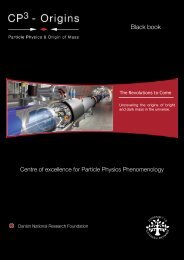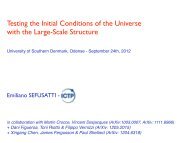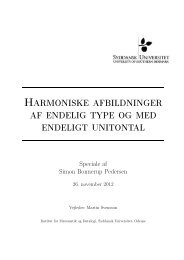PhD thesis - CP3-Origins
PhD thesis - CP3-Origins
PhD thesis - CP3-Origins
You also want an ePaper? Increase the reach of your titles
YUMPU automatically turns print PDFs into web optimized ePapers that Google loves.
QCD and Chiral Symmetry Breaking 27Considering the two flavor QCD with equal quark masses m u = m d = m ≠ 0 thevector symmetry in question is the SU(2) V . If this symmetry were broken there wouldbe Goldstone bosons associated with the scalar currents.Let us consider Euclidean correlator〈〉∣C Γ = 0 ∣J ūd (x)J ¯du (y) ∣ 0 , (3.31)where J ūd = ūΓd are quark currents withΓ = 1, γ 5 , iγ µ , γ µ γ 5 , iσ µν . (3.32)Using the results derived in the section 3.2, we can present the correlators asC Γ (x, y) = 1 Z [Π n(m − iλ)] 2 Tr {ΓG(x, y)ΓG(y, x)} , (3.33)where G(x, y) is the Euclidean Green function of the u- and d-quarks in a given gaugefield backgroundG(x, y) = ∑ ku k (x)u † k (y)m − iλ k. (3.34)Note that we have explicitly employed the fact that the masses are degenerate. Inaddition, we have assumed that the common mass is real i.e. the θ angle of the QCDvacuum is zero.Using the symmetry u k → γ 5 u k , λ k → − λ k we can show thatγ 5 G(x, y)γ 5 = ∑ k[γ 5 u k (x)][γ 5 u k (y)] †m − iλ k= ∑ k[u k (x)u † k (y) ∑=m + iλ kk]u k (y)u † k (x)†m − iλ k(3.35)= G † (y, x).The Green function can be expanded over the full basisG(x, y) = s(x, y) + γ 5 p(x, y) + iγ µ v µ (x, y) + γ µ γ 5 a µ a µ (x, y) + 1 2 iσ µνt µν , (3.36)








